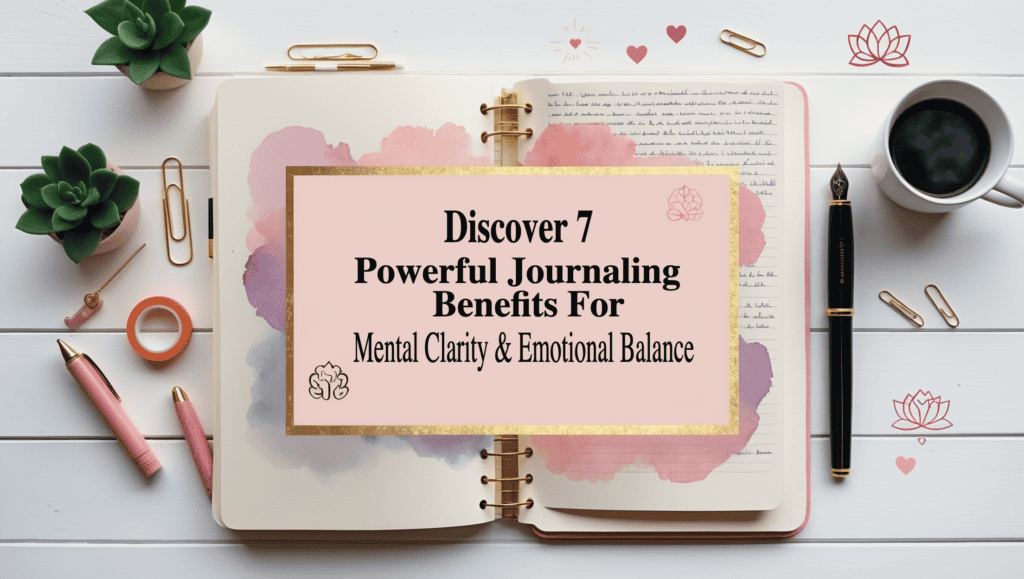
Have you ever felt overwhelmed by swirling thoughts and emotions that just won’t settle? That mental chatter that keeps you up at night or distracts you during important moments? I’ve been there too! Journaling has been my anchor through life’s storms, providing a simple yet powerful way to untangle my thoughts and find emotional equilibrium. This practice of putting pen to paper (or fingers to keyboard) creates a sacred space where chaos transforms into clarity, and overwhelming emotions find healthy expression.
Journaling isn’t just a feel-good practice—it’s backed by science as a powerful tool for mental health and emotional well-being. Research shows that regular journaling can reduce stress, improve immune function, boost mood, and even help heal physical wounds faster! Whether you’re navigating anxiety, seeking greater self-awareness, or simply wanting to document your life journey, journaling offers a customizable path to greater mental clarity and emotional balance. In this guide, I’ll share everything you need to know to harness the transformative power of journaling for yourself.
This post may contain some affiliate links. I only recommend products and services I genuinely believe in. Additionally, some content on this website may have been created with the help of AI.
What You Might Need
- A dedicated notebook or journal that brings you joy
- Your favorite pens or writing tools
- A quiet, comfortable space free from distractions
- 10-15 minutes of uninterrupted time
- Optional: journaling prompts for days when inspiration is lacking
- A non-judgmental attitude and willingness to be honest with yourself
- Patience as you develop your practice
1. Understanding the Science Behind Journaling Benefits
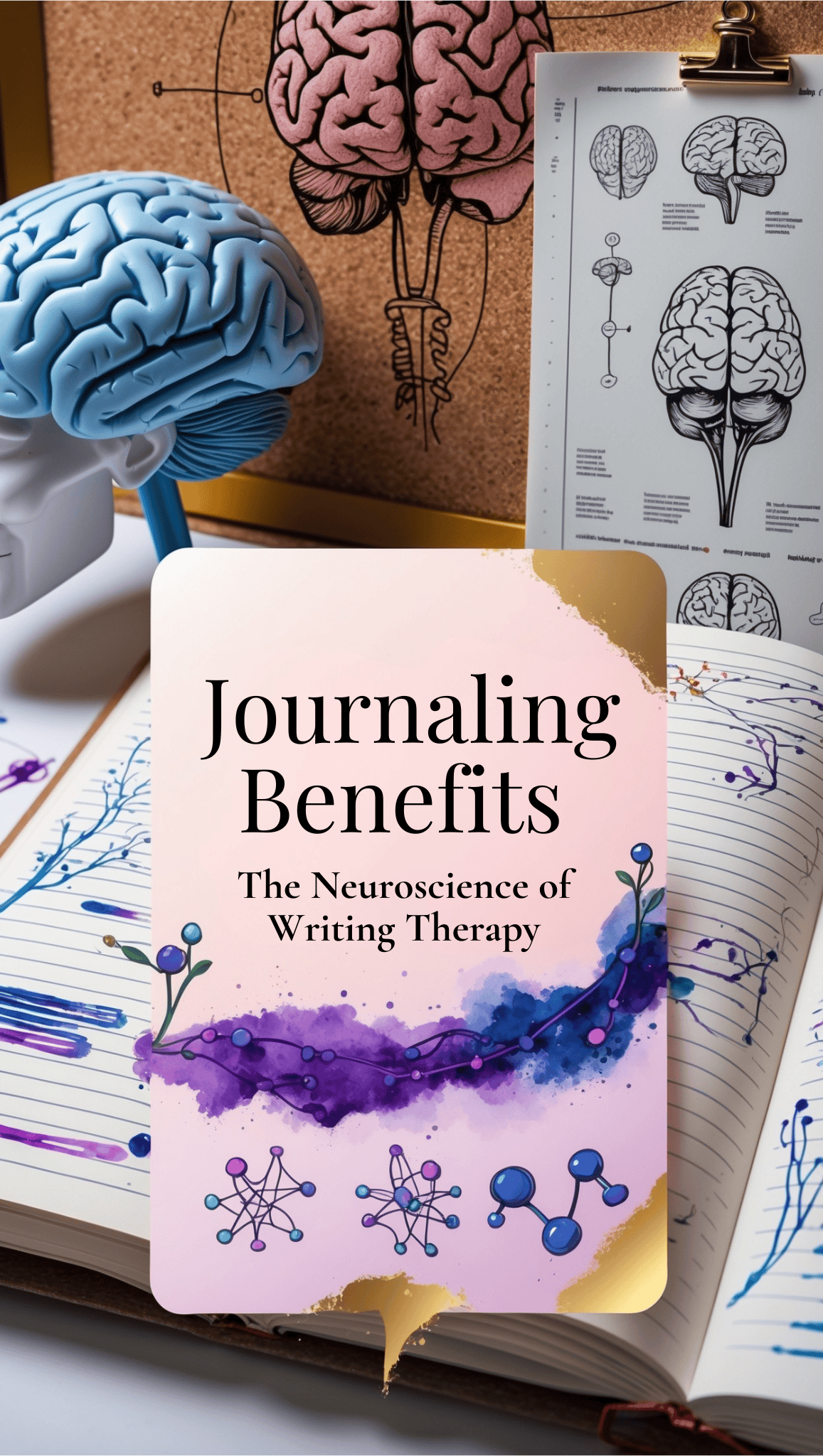
When I first started journaling, I had no idea about the incredible things happening in my brain with each word I wrote! The science behind journaling’s benefits continues to amaze me years into my practice. There’s something almost magical about how transferring thoughts from mind to paper can create such profound shifts in our mental and emotional landscapes. What appears to be a simple act of writing actually triggers complex neurological processes that help reorganize thoughts, process emotions, and create new neural pathways that support emotional regulation.
Research shows that expressive writing activates different areas of the brain than speaking or thinking silently. When we journal, we engage both hemispheres of the brain—the logical left side through the act of writing and language processing, and the creative right side through emotional expression and memory processing. This whole-brain engagement creates a uniquely effective therapeutic experience that helps reduce stress hormones like cortisol while increasing feel-good neurotransmitters that boost our mood and sense of well-being.
The Neuroscience of Writing Therapy
Writing therapy engages multiple brain regions simultaneously, including the prefrontal cortex responsible for executive function and emotional regulation. This activation helps strengthen neural connections between thoughts and feelings, creating greater emotional awareness and control. Studies using brain imaging technology have shown increased activity in areas associated with memory processing and emotional integration during expressive writing sessions. As these neural pathways strengthen through consistent journaling practice, many people experience decreased rumination and greater cognitive flexibility when facing challenges.
How Regular Journaling Alters Brain Chemistry
Consistent journaling practice has been shown to reduce cortisol levels, our body’s primary stress hormone. This reduction occurs because writing helps process emotional experiences in a safe, contained way that signals to our body that the “threat” has been addressed. Beyond stress reduction, journaling increases production of mood-enhancing neurotransmitters like serotonin and dopamine. This positive shift in brain chemistry explains why many people report feeling lighter, more optimistic, and emotionally balanced after a journaling session, with effects that accumulate and strengthen over time with regular practice.
Steps to Harness the Science of Journaling
- Set aside 15-20 minutes at least three times weekly for expressive writing
- Focus on emotional processing rather than perfect grammar or spelling
- Write continuously without censoring yourself for maximum benefit
- Include both emotional content and cognitive analysis of situations
- Be consistent to strengthen the neural pathways associated with emotional regulation
- Pay attention to physical sensations that arise during writing
- Notice patterns in your emotional responses over time
Picture This
You sit in your favorite cozy chair, journal open on your lap. As your pen glides across the page, something shifts—the mental fog that’s been clouding your thoughts begins to lift. Your shoulders relax, your breathing deepens, and you feel the physical sensation of stress hormones receding as clarity emerges. With each sentence, neural pathways in your brain strengthen, creating new connections that help you process emotions more effectively. This isn’t just writing—it’s a biological transformation happening with every journaling benefits you unlock, rewiring your brain for greater resilience and emotional balance that extends far beyond your journaling session.
2. Essential Journaling Methods for Mental Clarity
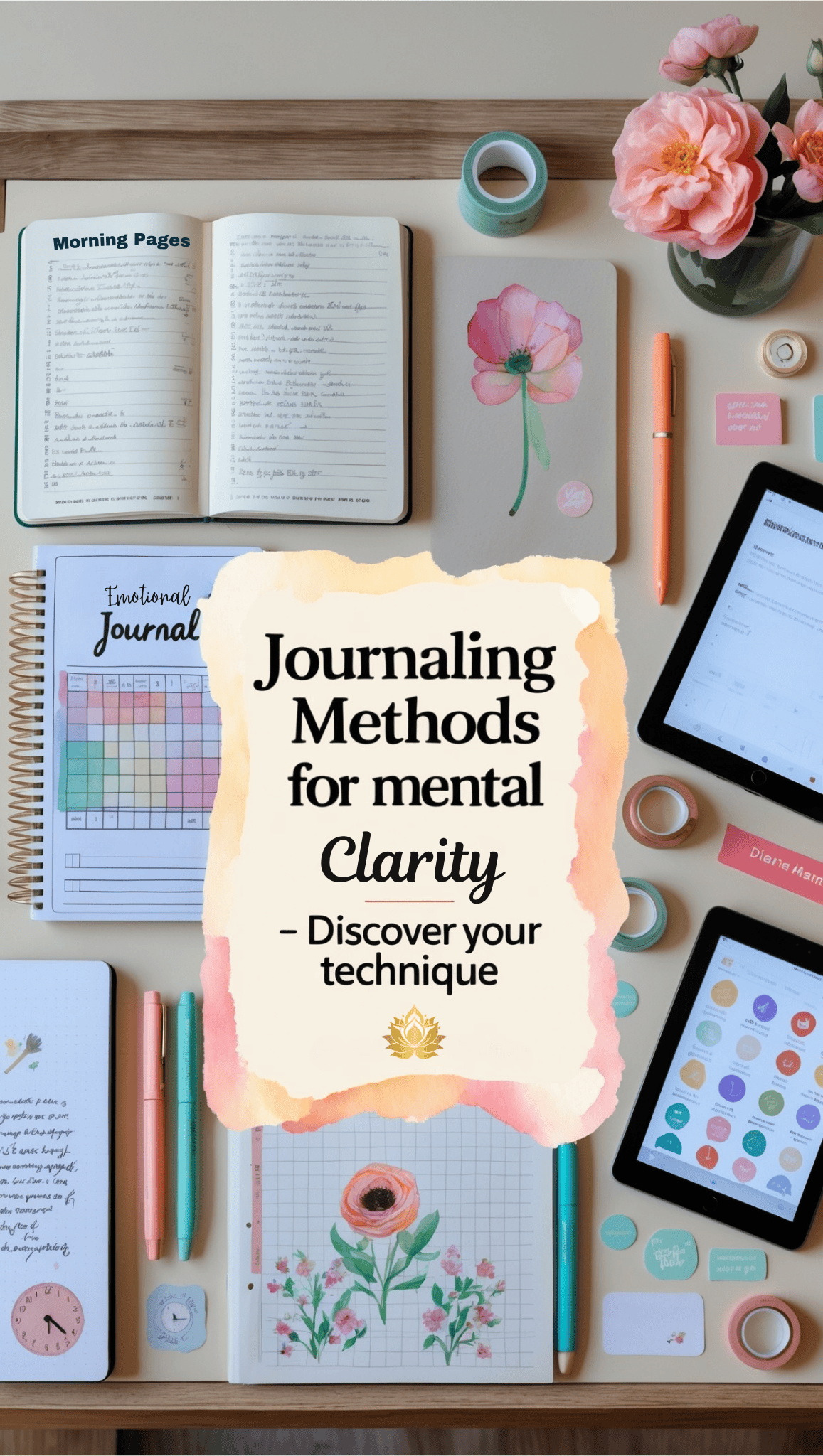
Finding the right journaling method feels like discovering a key that unlocks parts of yourself you didn’t know existed! When I first started journaling, I tried to follow rigid structures I found online, but I quickly learned that the most effective approach is the one that resonates personally with you. Different methods serve different purposes—some help organize chaotic thoughts, others process deep emotions, while still others foster gratitude and positive thinking. The beauty of journaling lies in its flexibility and how it can evolve alongside your needs.
I’ve experimented with countless approaches over the years, and I’ve found that mixing methods based on what my mind and heart need on any given day yields the most powerful results. Some mornings call for rapid stream-of-consciousness writing to clear mental clutter, while other times I benefit from structured prompts that guide me toward specific insights. Don’t be afraid to customize and combine techniques to create a journaling practice that feels both nurturing and productive for your unique situation.
Morning Pages Technique
The Morning Pages technique involves writing three full pages of stream-of-consciousness content immediately upon waking. This method, popularized by Julia Cameron in “The Artist’s Way,” serves as a mental clearing exercise that helps dump anxious thoughts, worries, and mental clutter before your day begins. Many practitioners report increased creativity, clearer thinking, and reduced anxiety throughout the day after completing their morning pages. The key is writing without stopping to edit or judge what emerges, allowing your authentic thoughts and feelings to flow freely without censorship.
Structured vs. Unstructured Journaling Approaches
Structured journaling follows specific formats, prompts, or templates that guide your writing process toward particular outcomes or insights. Examples include gratitude journals, decision-making frameworks, or guided reflection prompts that help focus your thinking in productive directions. Unstructured journaling, by contrast, allows complete freedom to write whatever comes to mind without predetermined direction or purpose. Both approaches offer unique benefits—structured methods provide helpful scaffolding when you’re feeling lost or unfocused, while unstructured writing often reveals surprising insights and connections that might remain hidden within more directed formats.
Digital vs. Paper Journaling Considerations
Paper journaling creates a sensory experience that many find therapeutic—the feel of pen on paper, the physical act of writing, and the absence of digital distractions can deepen your connection to the journaling process. Digital journaling, however, offers conveniences like searchability, password protection, and accessibility across devices, making it easier to maintain consistency for some people. Research suggests handwriting may provide stronger cognitive and emotional processing benefits, but the best choice ultimately depends on what helps you maintain a consistent practice and feel most comfortable expressing your authentic thoughts and feelings.
How to Create Your Personalized Journaling Method
- Experiment with different techniques to discover what feels most effective
- Combine elements from various methods to create your unique approach
- Schedule your journaling time when you feel most mentally receptive
- Create a pleasing environment that encourages openness and reflection
- Use prompts when you’re feeling stuck or want to explore specific themes
- Listen to your intuition about what you need from each session
- Be willing to adapt your method as your needs evolve
Picture This
You’ve created a journaling sanctuary in the corner of your bedroom—a comfortable chair beside a small table holding your journal collection, favorite pens, and a gently scented candle. Morning light filters through sheer curtains as you settle in, selecting the perfect journal method for today’s needs. As you write, your thoughts transform from scattered fragments to coherent patterns on the page, each journaling benefits moment bringing greater mental clarity. The mental fog that’s been following you for days dissipates with each sentence, replaced by insights that were hidden beneath the surface of your consciousness. When you close your journal, you carry this newfound clarity with you, approaching your day with a calm centeredness that wasn’t there before.
3. Transforming Emotions Through Daily Writing Practice
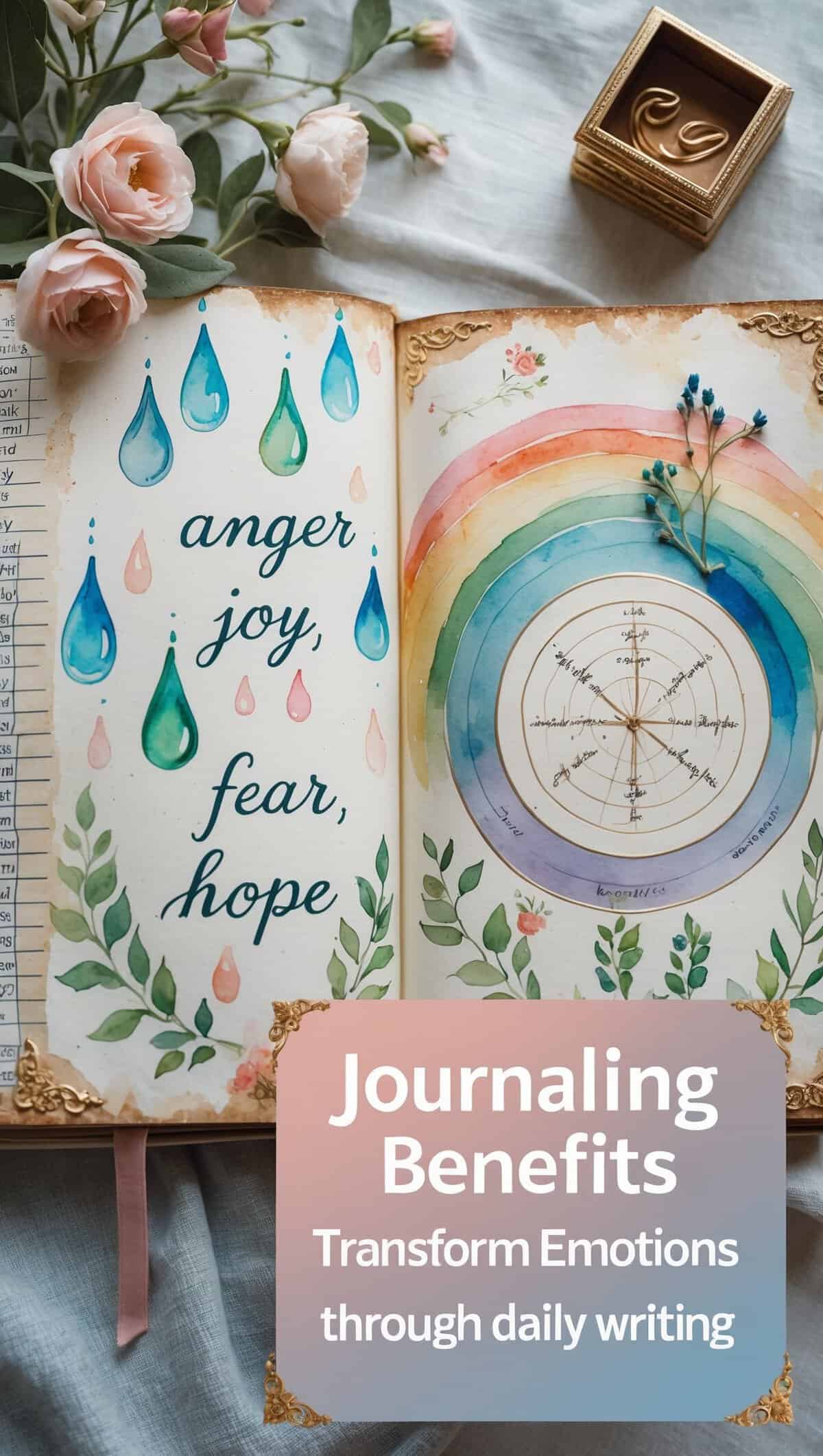
My journaling journey began during one of the most emotionally turbulent periods of my life, and I was genuinely surprised by how quickly putting pen to paper helped me navigate overwhelming feelings! There’s something profoundly healing about witnessing your own emotions through the safe distance that writing creates. Our emotions often feel all-consuming when they’re swirling inside our minds, but journaling helps externalize them, creating space between ourselves and our feelings that allows us to respond rather than react.
The transformative power of journaling for emotional health lies in its ability to help us name, process, and understand our feelings without judgment. I’ve found that emotions that seem impossibly complex when experienced internally often become clearer and more manageable when expressed on paper. Regular emotional writing practice also helps us recognize patterns in our emotional responses over time, increasing our emotional intelligence and self-awareness in ways that benefit all areas of our lives.
Using Journaling to Navigate Anxiety and Stress
Journaling creates a container for anxious thoughts and worries, preventing them from circulating endlessly in your mind. When we write about our anxieties, we activate the analytical part of our brain, helping transform vague fears into specific concerns that can be addressed more effectively. Research shows that expressive writing can significantly reduce both psychological and physical symptoms of anxiety and stress. The act of putting worries on paper helps create psychological distance from them, making them feel more manageable and less overwhelming.
Writing Through Grief and Loss
Journaling provides a private, compassionate space to express and process grief in all its complex forms. Writing about loss helps externalize painful emotions and create meaningful narratives around difficult experiences, which research shows is essential for healing. Many people find that journaling helps them maintain a connection with what they’ve lost while simultaneously helping them adapt to their new reality. The journal becomes both witness and companion through the grieving process, offering a consistent outlet for expression when other support systems might not be available or able to continually receive intense emotions.
Emotion-Focused Journaling Techniques
Journaling can be a powerful tool for identifying and capturing complex emotions that are often difficult to express verbally. By writing down our feelings, we can gain clarity and insight into the underlying causes of our emotional responses. This process helps us develop greater emotional intelligence and self-awareness, leading to more effective emotional regulation in daily life. Regular emotion-focused journaling has been shown to reduce symptoms of depression and anxiety, while increasing overall emotional well-being and resilience.
How to Transform Emotions Through Writing
- Begin by naming and acknowledging what you’re feeling without judgment
- Describe physical sensations associated with your emotions
- Explore possible triggers or patterns behind recurring feelings
- Write a dialogue between yourself and a difficult emotion
- Use color-coding to track different emotional states over time
- Practice self-compassion in your writing, especially with difficult feelings
- Look for actionable insights that emerge from emotional processing
- Create a “feelings inventory” to expand your emotional vocabulary
Picture This
You’re sitting with your journal after a particularly challenging day, emotions buzzing like static beneath your skin. As your pen touches paper, the emotional static begins to organize itself into clear signals you can interpret and understand. Words flow, sometimes messy and raw, other times measured and insightful, each sentence a release valve for tension you’ve been carrying. You name feelings that were previously just uncomfortable sensations, tracing their origins and patterns across your life. Through this journaling benefits process, the overwhelming emotions that felt like a stormy sea transform into navigable waters with recognizable currents and tides. When you close your journal, you feel lighter—the emotions haven’t disappeared, but they’ve been honored, understood, and integrated rather than avoided or suppressed.
4. Journaling for Enhanced Problem-Solving Abilities
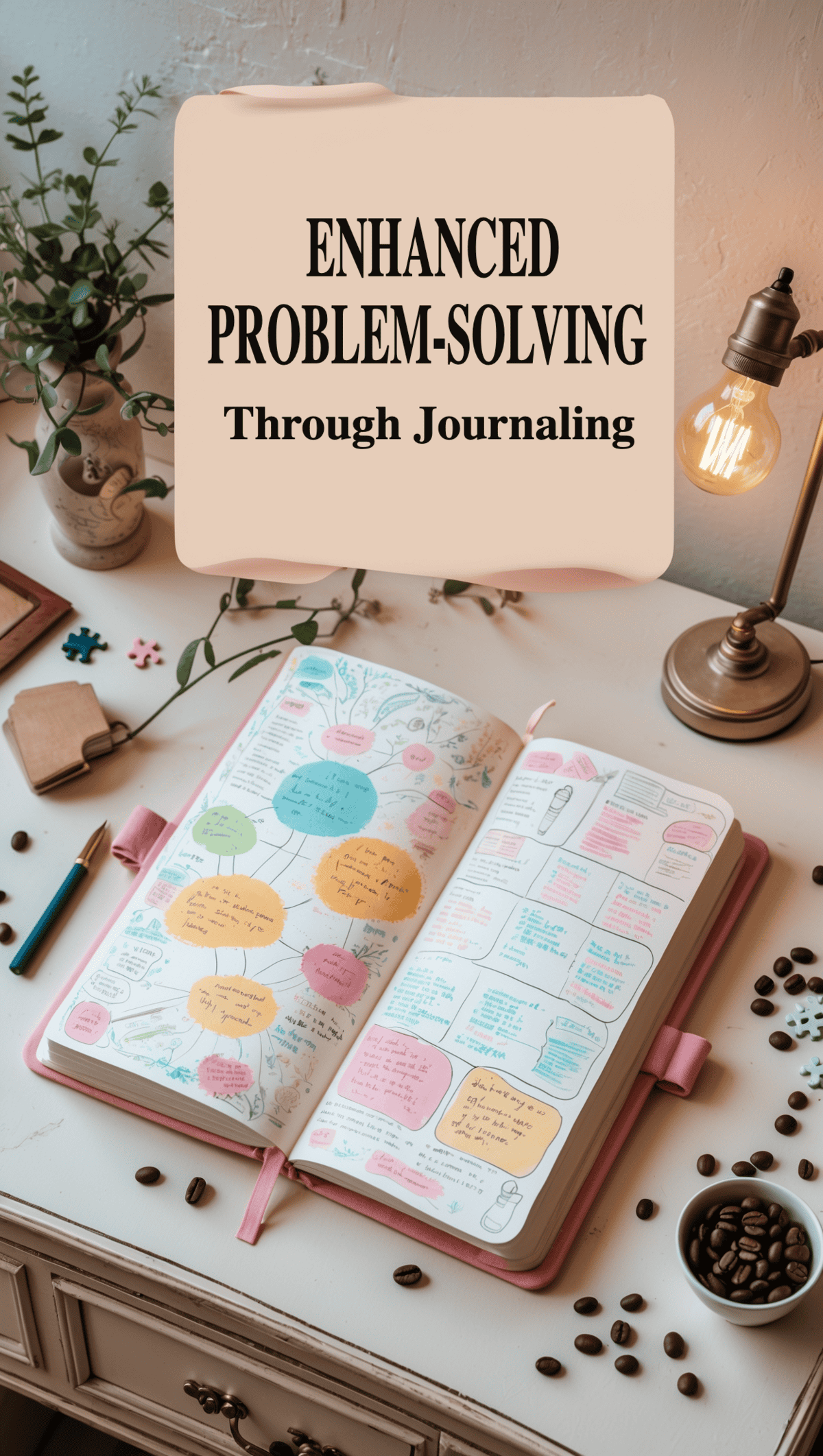
I’ve lost count of how many seemingly unsolvable problems have unraveled themselves through my journaling practice! There’s something almost magical about the way writing externalizes our thoughts, creating the mental space needed for fresh perspectives and creative solutions. When problems remain locked inside our minds, we tend to circle through the same thought patterns repeatedly, but journaling breaks this cycle by literally moving our thoughts from our heads onto paper where we can examine them more objectively.
My most profound problem-solving breakthroughs have happened when I’ve used my journal to approach challenges from multiple angles, asking different questions and exploring possibilities I might never have considered through mental contemplation alone. The act of writing slows down our thinking process, allowing for deeper analysis and more thorough consideration of options than our rapid-fire mental processing typically permits. This deliberate pace combined with the clarity that comes from seeing our thoughts in black and white creates ideal conditions for innovative problem-solving.
The Decision Matrix Journaling Method
The Decision Matrix method transforms complex choices into manageable components through structured journaling. Begin by creating a table with your options listed vertically and important decision factors horizontally, then assign weight values to each factor and score each option accordingly. This technique brings clarity to difficult decisions by making your thinking process explicit and visual on the page. The act of breaking down complex choices into discrete elements often reveals preferences and priorities you weren’t fully conscious of, leading to decisions that better align with your true values and goals.
Using Lists and Mind Maps in Your Journal
List-making and mind mapping are powerful visual thinking techniques that organize scattered thoughts into coherent structures. Lists create linear clarity, helping prioritize tasks or considerations in order of importance, while mind maps mimic the brain’s natural associative thinking patterns, allowing for non-linear exploration of ideas and connections. Both techniques make relationships between concepts visible, revealing patterns that might remain hidden in traditional paragraph journaling. Many problem-solvers find that these visual approaches help bypass mental blocks and generate creative solutions by accessing different cognitive pathways than narrative writing.
Breaking Down Complex Problems Through Writing
The act of writing forces us to articulate vague concerns into specific, addressable problems. When we define problems clearly on paper, they often become less overwhelming and more manageable. Journaling allows us to separate emotional reactions from the factual elements of a situation, leading to more objective analysis. Many people discover that what initially seemed like one insurmountable problem is actually several smaller challenges that can be addressed individually, making progress possible where it previously seemed blocked.
How to Enhance Your Problem-Solving Through Journaling
- Write out the problem in clear, specific terms without judgment
- List all possible solutions without immediately evaluating them
- Explore pros and cons of each potential solution in writing
- Use “what if” scenarios to explore different approaches
- Create a mind map to visualize connections between different aspects
- Write from different perspectives to gain new insights
- Set a timer for focused “solution generation” writing sessions
- Track implementation steps and outcomes for future reference
Picture This
You open your journal to a fresh page, sketching out a mind map of the problem that’s been keeping you awake at night. As your pen moves across the paper, connections emerge that weren’t visible when these thoughts were trapped in your head. The complex challenge breaks down into manageable components, each branching into potential solutions you hadn’t previously considered. Through this journaling benefits exercise, clarity emerges from confusion, and what seemed like an unsolvable dilemma transforms into a series of actionable steps. Later, reviewing your journal entries about similar challenges, you notice patterns in your problem-solving approach that help you tackle new situations with greater confidence and creativity. Your journal has become not just a record of your thoughts but a powerful tool that expands your cognitive capabilities and reveals solutions hidden in plain sight.
5. Building Self-Awareness Through Reflective Writing
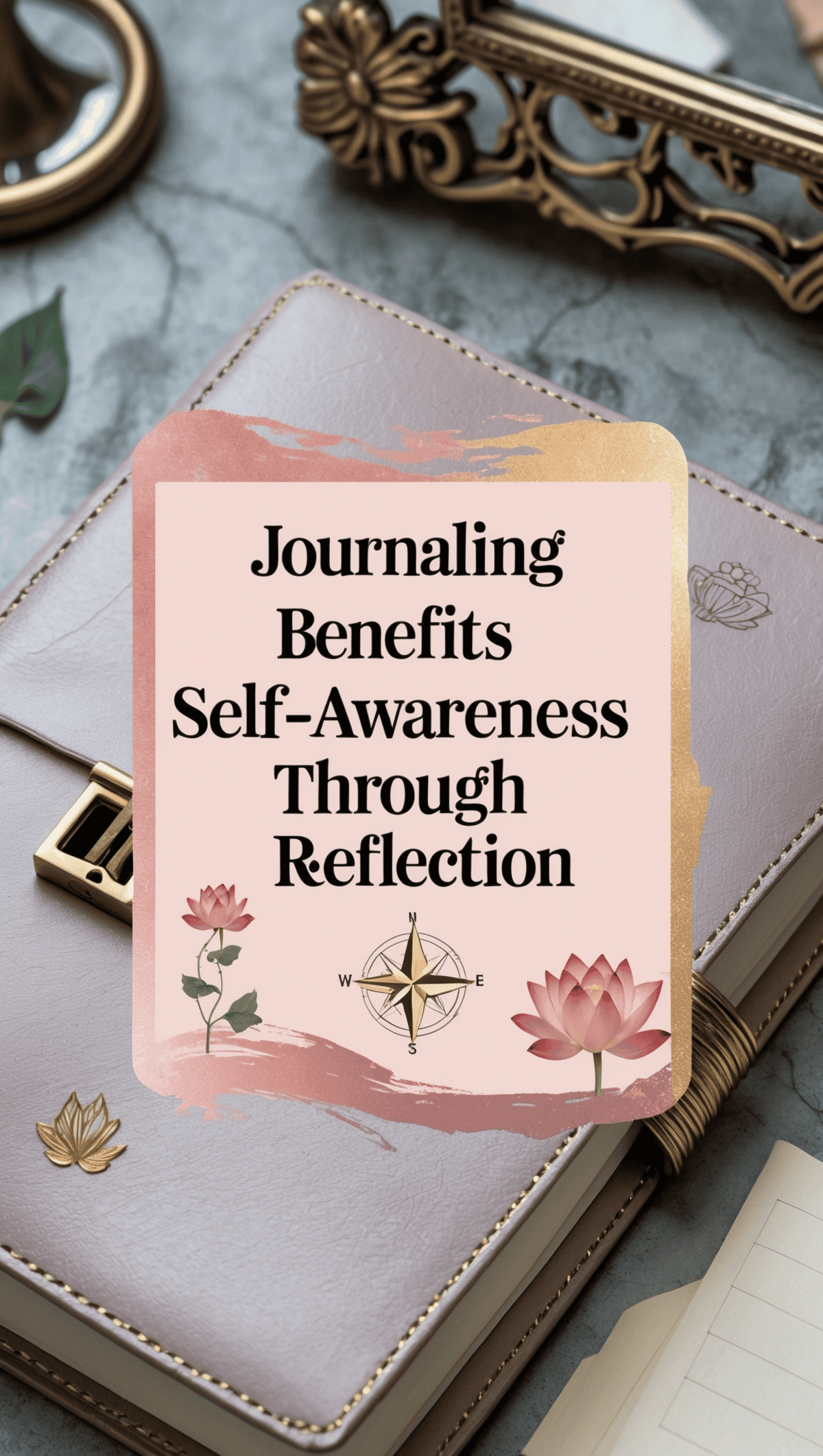
My journaling practice has become the most honest mirror I own, reflecting aspects of myself I might otherwise never see clearly! Self-awareness is perhaps the most transformative benefit of consistent journaling, as it helps us recognize patterns, triggers, and tendencies that operate beneath our conscious awareness. Through regular reflective writing, I’ve uncovered blind spots, acknowledged uncomfortable truths, and celebrated strengths that I might have otherwise overlooked in the busy pace of daily life.
The beauty of building self-awareness through journaling is that it happens gradually and gently, allowing us to approach self-discovery with curiosity rather than criticism. By creating a private space for authentic reflection, free from external judgment, we can explore our inner landscape with the compassionate attention needed for genuine growth. This growing self-knowledge becomes the foundation for more intentional living, better decision-making, and healthier relationships with ourselves and others.
Shadow Work Journaling Techniques
Shadow work journaling involves exploring the hidden or disowned aspects of ourselves—the parts we typically avoid or deny. Through specific prompts and exercises, shadow journaling helps us acknowledge and integrate these aspects rather than suppressing them. This courageous form of self-inquiry often reveals how qualities we reject in ourselves actually contain valuable gifts and strengths when properly understood and integrated. Many practitioners find that shadow work journaling leads to greater self-acceptance, reduced projection onto others, and more authentic living as energy previously used for repression becomes available for creative expression.
Identity Exploration Through Written Reflection
Identity journaling helps us explore and articulate who we are beneath social roles and expectations. Through writing exercises focused on values, beliefs, strengths, and authentic desires, we develop a stronger sense of self that remains stable even as circumstances change. Regular reflection on our evolving identity helps us make choices aligned with our true selves rather than external pressures or outdated self-concepts. Many people discover through identity journaling that they are far more multifaceted than they previously believed, containing seemingly contradictory aspects that can actually complement each other when consciously integrated.
Tracking Personal Growth and Patterns
One of the most valuable aspects of reflective journaling is the ability to observe patterns in your thoughts, emotions, and behaviors over time. Regularly reviewing past journal entries reveals recurring themes and cycles that might otherwise remain invisible in day-to-day life. This longitudinal perspective helps identify areas of growth and persistent challenges, providing objective evidence of progress that can be encouraging during difficult periods. Many journalers find that pattern recognition leads to greater self-compassion as they recognize how certain triggers consistently activate specific responses, allowing them to implement more effective coping strategies.
How to Deepen Self-Awareness Through Journaling
- Schedule regular “check-in” journaling sessions to reflect on your internal state
- Use prompts that challenge you to explore uncomfortable truths
- Write “stream of consciousness” style to bypass your inner censor
- Create timeline entries that connect past experiences to present patterns
- Practice writing from the perspective of different parts of yourself
- Review old journal entries periodically to track your evolution
- Ask deeper “why” questions about your reactions and choices
- Use “I notice…” statements to build mindful self-observation skills
Picture This
Curled up in your reading nook with a cup of tea beside you, your journal open in your lap, you begin reflecting on a recent interaction that left you feeling unsettled. As you write, layers of defensive justification fall away, revealing a pattern of reactivity you hadn’t previously recognized. The journaling benefits of this moment of self-awareness feel both uncomfortable and liberating—a truth seen clearly can now be addressed directly. You notice connections between this trigger and childhood experiences, understanding dawning like gentle sunlight rather than harsh fluorescence. This isn’t self-criticism but compassionate witnessing, creating space for growth where there was once only reaction. When you close your journal, you carry this new awareness with you, a quiet observer alongside your experiencing self, adding a dimension of choice where once there was only automatic response.
6. Creating a Sustainable Journaling Practice

Confession time: despite all its benefits, my journaling practice hasn’t always been consistent! Like any meaningful habit, journaling requires intention and commitment to become a sustainable part of our lives. The most beautiful journal in the world won’t help if it stays closed on your shelf, which is why finding an approach that realistically fits into your life is crucial for long-term success. The good news is that effective journaling doesn’t require hours of daily writing or literary brilliance—even brief, regular sessions yield powerful benefits.
I’ve learned through trial and error that sustainability comes from creating a practice that feels nurturing rather than obligatory. When journaling becomes another item on your to-do list, resistance naturally arises. When it becomes a gift you give yourself—a moment of pause and presence in a busy day—you’ll find yourself naturally drawn to your journal. Consider what conditions would make journaling feel like a refuge rather than a responsibility, and design your practice accordingly.
Overcoming Common Journaling Obstacles
Writer’s block is perhaps the most common obstacle to consistent journaling, often stemming from perfectionism or unclear intentions. Combat this by keeping a list of favorite prompts for stuck days or beginning with a simple “brain dump” of whatever’s on your mind without concern for quality or relevance. Time constraints present another significant challenge in our busy lives. Address this by identifying small pockets of time throughout your day or linking journaling to existing habits (like morning coffee) to create natural triggers for your practice. Many people also struggle with privacy concerns, fearing others might read their intimate thoughts. Consider keeping digital journals with password protection or finding secure storage for physical journals to create the safety needed for authentic expression.
Creating Sacred Time and Space for Writing
The environment where you journal significantly impacts the depth and consistency of your practice. Create a dedicated journaling space that feels inviting and free from distractions, even if it’s simply a special corner of your home. This physical space becomes a visual cue that helps transition your mind into a reflective state. Similarly, designating specific times for journaling helps establish it as a non-negotiable part of your routine. Many find that early morning journaling sets a positive tone for the day, while evening reflection helps process experiences and clear the mind before sleep. Experiment with different timing to discover when your mind feels most receptive to introspection and insight.
Integrating Journaling with Daily Life
Successful journaling practices seamlessly integrate with your existing lifestyle rather than competing with it. Look for natural moments in your day that could include brief journaling sessions—perhaps while waiting for your coffee to brew or during your lunch break. Consider how journaling might enhance activities you already enjoy, like taking your journal to a favorite café or park. Many people find that habit stacking—connecting journaling to an established routine—increases consistency substantially. The easier and more enjoyable you make your practice, the more likely it will become a sustainable part of your life rather than a short-lived attempt that fades with time.
How to Build a Sustainable Journaling Habit
- Start with just 5 minutes daily to establish the habit without overwhelm
- Create environmental triggers that remind you to journal
- Keep journaling supplies easily accessible where you’ll use them
- Track your journaling streak to build momentum and accountability
- Join journaling groups or challenges for community support
- Set realistic expectations that allow for flexibility
- Connect your practice to values that matter deeply to you
- Periodically refresh your approach when motivation wanes
Picture This
It’s become as natural as brushing your teeth—reaching for your journal as the kettle boils for your morning tea. Your journaling corner welcomes you: the chair with the perfect lumbar support, the small table that holds your favorite pen, the soft light that makes early mornings gentle. No grand ceremony, just a quiet ritual that grounds your day. This isn’t the dramatic two-hour soul-searching session you once imagined journaling had to be—it’s ten minutes of presence, of showing up for yourself before the world demands your attention. The journaling benefits accumulate not through intensity but through consistency—each brief session building upon the last, creating a foundation of self-awareness and emotional clarity that supports everything else in your life. When life gets chaotic, this sustainable practice becomes not another obligation but a sanctuary you naturally turn toward.
7. Advanced Journaling Techniques for Deeper Insights
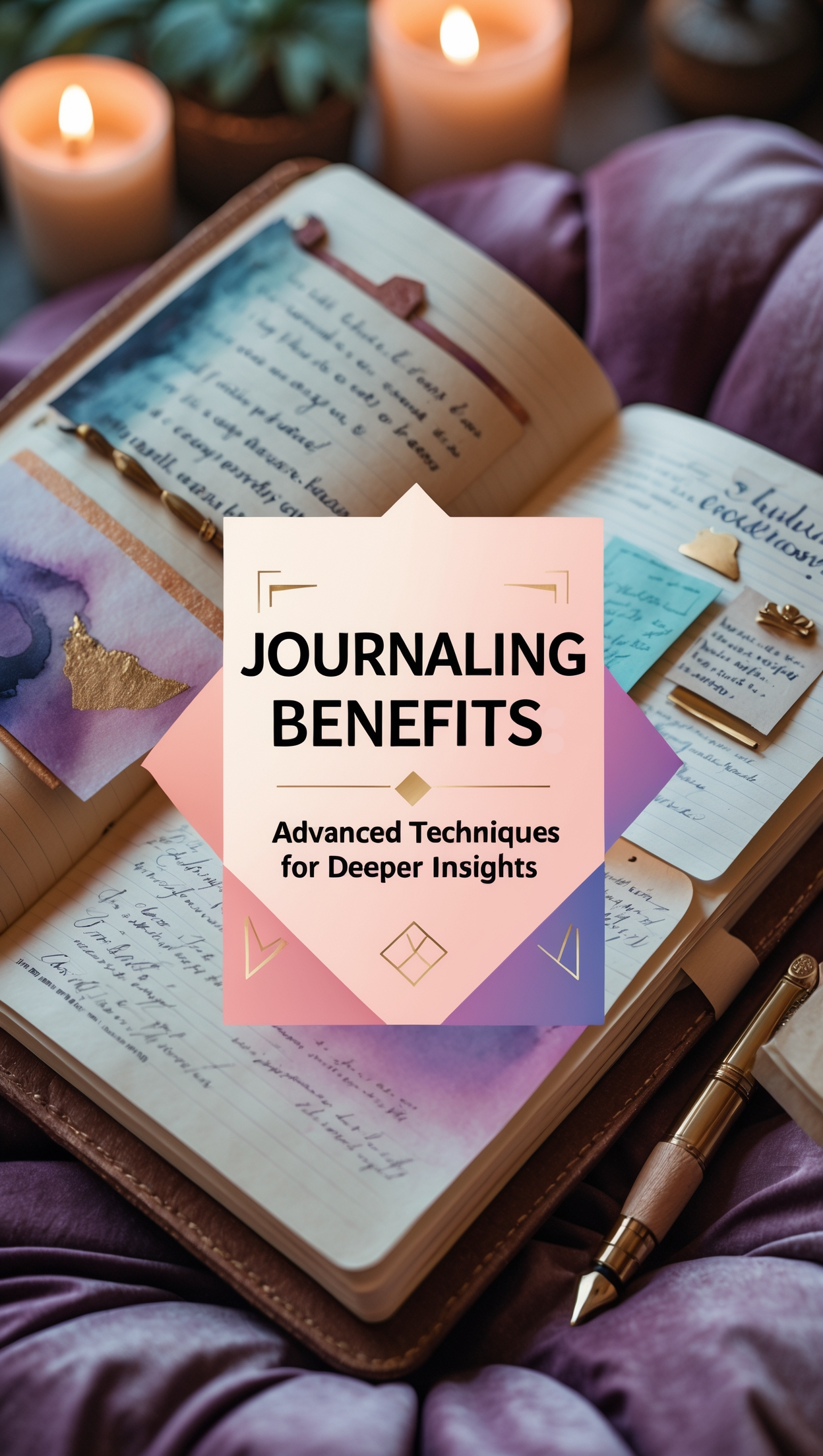
Once you’ve established a comfortable journaling rhythm, a world of advanced techniques awaits to deepen your practice and unlock new dimensions of insight! I remember the first time I ventured beyond basic reflective writing into more structured methodologies—it felt like discovering hidden rooms in a house I thought I knew completely. Advanced journaling approaches often incorporate elements from psychology, creative writing, mindfulness practices, and even artistic expression to access different levels of awareness and understanding.
These sophisticated techniques aren’t necessarily more time-consuming or difficult than basic journaling, but they often yield surprisingly profound results by accessing parts of your consciousness that standard writing might not reach. I’ve found that incorporating these methods during periods when my regular journaling feels stagnant or when I’m working through particularly complex situations helps breakthrough insights emerge. Think of these approaches as specialized tools in your journaling toolkit, each designed for specific types of inner work.
Unsent Letter Writing Technique
The unsent letter technique provides a powerful way to process complicated feelings toward others without the potential consequences of direct communication. This method involves writing letters you never intend to send, allowing complete emotional honesty and expression without concern for the recipient’s reaction. Many practitioners find this approach especially helpful for processing anger, grief, or unresolved feelings from relationships, particularly when direct communication isn’t possible or advisable. The therapeutic value comes from expressing suppressed emotions fully while maintaining boundaries that protect both yourself and others from potentially harmful interactions that might result from raw emotional expression.
Future Self Journaling Exercises
Future self journaling creates a dialogue between your present consciousness and your wisest, most evolved future self. By writing from the perspective of who you aspire to become, you access guidance and perspective not always available from your current vantage point. This technique helps clarify long-term values and priorities while building an emotional connection to your desired future, increasing motivation and consistent action toward meaningful goals. Many practitioners report that regularly connecting with their future self helps them make decisions with greater wisdom and foresight, balancing immediate desires with long-term well-being.
Dialogue Journaling Method
Dialogue journaling creates written conversations between different aspects of yourself, external entities, or abstract concepts. This technique, similar to the psychological practice of chair work, helps externalize different perspectives or parts of your psyche for clearer examination and integration. Through written dialogue, you might converse with your inner critic, your body, a challenging emotion, or even objects and symbols that emerge in your awareness. Many people discover surprising wisdom and insight through these conversations, accessing knowledge that remains hidden when writing from a single perspective and resolving internal conflicts through facilitated communication between different parts of themselves.
How to Implement Advanced Journaling Techniques
- Schedule dedicated sessions for these methods separate from daily journaling
- Create a relaxed, distraction-free environment for deeper introspection
- Begin with a brief meditation to center yourself before advanced techniques
- Set clear intentions for what you hope to explore or understand
- Allow unexpected directions to emerge without forcing specific outcomes
- Follow intuitive prompts that arise during your writing process
- Review insights gained and consider how to integrate them
- Combine different techniques to address complex situations
Picture This
In the soft glow of evening light, you settle into a deeper journaling session than your usual morning routine allows. Tonight, you’re writing a dialogue between your current self and the version of you that exists five years in the future. As you alternate between perspectives, writing first as your present self with all your questions and uncertainties, then responding as your future self with surprising wisdom and compassion, something shifts in your understanding. Insights emerge that weren’t accessible through conventional thinking—a clarity about priorities and possibilities that feels both revelatory and deeply familiar. These journaling benefits transcend simple reflection, tapping into a wellspring of inner wisdom you didn’t realize you possessed. When you finally close your journal, you carry not just new thoughts but a palpable sense of connection to a larger version of yourself that exists beyond current limitations.
Final Thoughts

Journaling truly stands as one of the most accessible and powerful tools we have for cultivating mental clarity and emotional balance in our increasingly complex lives. Throughout this guide, we’ve explored the neuroscience behind writing’s remarkable effects on our brains, various methodologies to match different needs and preferences, and techniques for processing emotions, solving problems, building self-awareness, and accessing deeper wisdom. What makes journaling so extraordinary is its adaptability—this single practice can evolve alongside you throughout your entire life journey, offering different benefits as your needs change.
I encourage you to approach journaling with both commitment and compassion. Commitment provides the consistency needed for transformative results, while compassion allows space for imperfection in your practice. Remember that there’s no single “right way” to journal—your unique approach will develop naturally as you experiment and discover what resonates most deeply with you. The simple act of showing up regularly with pen and paper (or keyboard) creates a foundation for profound personal growth and emotional wellbeing that compounds over time.
As you embark on or deepen your journaling practice, try to release expectations about immediate results or “doing it correctly.” Instead, approach each session with curiosity about what might emerge when you create space for your authentic thoughts and feelings to appear on the page. Some days will bring breakthrough insights, while others might feel more routine—both are valuable parts of the process. What matters most is creating a consistent container for self-reflection and expression that honors your internal experience in a world that rarely slows down enough for genuine introspection.
This post may contain some affiliate links. I only recommend products and services I genuinely believe in. Additionally, some content on this website may have been created with the help of AI.
Frequently Asked Questions
How long should I journal each day to see benefits?
Research suggests that journaling for just 15-20 minutes three to five times per week can produce significant mental and emotional benefits. Consistency matters more than duration, so a shorter daily practice often yields better results than occasional lengthy sessions. Many people find that even 5 minutes of focused journaling provides valuable clarity and emotional processing. The key is finding a time commitment that feels sustainable for your lifestyle while still allowing enough space for meaningful reflection. If you’re just beginning, start with smaller sessions and gradually increase the duration as journaling becomes a more natural part of your routine.
What if I’m worried someone will read my journal?
Privacy concerns are completely valid and can significantly impact your ability to write honestly in your journal. Consider keeping digital journals with password protection or encryption if physical security is a concern. For paper journals, you might invest in a lockbox or find creative hiding places that provide peace of mind. Some people develop personal shorthand or code words for particularly sensitive topics, while others practice destroying pages after writing as a form of emotional release when privacy feels impossible to guarantee. Remember that the therapeutic value of journaling comes from honest expression, so finding a solution that allows you to write without self-censorship is essential for experiencing the full benefits of the practice.
How can I maintain consistency when I’m traveling or during busy periods?
Maintaining your journaling practice during disruptions requires flexibility and planning. Before traveling, decide whether you’ll bring a physical journal or use a digital alternative that doesn’t add weight to your luggage. Set realistic expectations during busy periods—perhaps shifting to bullet point entries or voice memos that can be expanded later when time permits. Many consistent journalers find that creating “non-negotiable” minimum sessions (even just 2-3 minutes) helps maintain the habit during chaotic times. Building journaling into existing travel routines (like morning coffee or before bed) can also help preserve consistency. Remember that adapting your practice during challenging periods is far better than abandoning it entirely until “perfect” conditions return.
What if I don’t know what to write about?
Feeling uncertain about what to write is a common experience even among longtime journalers. Keep a collection of prompts handy for days when inspiration is lacking—questions like “What am I feeling in my body right now?” or “What would make today meaningful?” can jumpstart your writing. Another effective approach is simply describing your current environment or the events of your day, which often naturally leads to deeper reflections. Many people find that setting a timer for 5 minutes and writing continuously without stopping—regardless of content—breaks through the initial barrier. Remember that there are no “wrong” journal entries; even documenting seeming mundanity creates valuable patterns and insights when viewed over time.
Can journaling replace therapy or other mental health treatments?
While journaling offers significant mental and emotional benefits, it works best as a complement to professional mental health care rather than a replacement. Journaling provides valuable self-reflection, emotional processing, and insight development that can enhance therapy by increasing self-awareness and providing material to discuss with your therapist. However, the guidance, feedback, and specialized techniques a trained mental health professional provides cannot be fully replicated through journaling alone. For mild stress management and personal growth, journaling may be sufficient, but for clinical concerns like depression, anxiety disorders, or trauma, it serves as a supportive practice alongside professional treatment rather than a standalone solution.
About The Author
Jahlila is a Transformational Whole Self and Wellness Lifestyle Empowerment Coach, a devoted mother, passionate writer, and a fervent advocate for holistic wellness. She is the creator of The Tri-Sync Method, a comprehensive coaching program designed to help women establish a personalized wellness and self-care lifestyle for enduring total health wellness.
Her journey has transitioned from focusing solely on health and fitness to embracing a broader mission: empowering women through holistic approaches that unite body, mind, and spirit. Jahlila is dedicated to teaching, coaching, writing, and speaking about how wellness intersects with a joyful, balanced life. Her mission is to motivate women to prioritize and achieve their wellness goals, fostering a deep connection between a vibrant lifestyle and true happiness. Ready to reclaim your vitality, achieve mental clarity, and embrace your wellness journey? Explore more at The Tri-Sync Method.Com
Don’t wait another day to start living your healthiest, happiest life. Schedule a Free Discovery Consultation with Jahlila today to explore how The Tri-Sync Method can transform your life. For additional questions or personalized guidance, please visit our Contact Page.




Leave a Reply